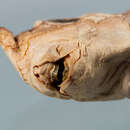en
names in breadcrumbs


The pale ghost shark (Hydrolagus bemisi) is a shortnose chimaera of the family Chimaeridae. It is endemic to New Zealand waters.
This species was first described by Dominique A. Didier in 2002.[1] Although it had been recognised, the description of this species was regarded as being important because of the increase in the commercial fishing of chimaera.[1]
Estimations of growth and age have only been attempted for a quarter of the species known.[2] This species has a medium-sized body with a tapered whip-like tail.[3] Its length is up to 1.12 m.[4] It can be distinguished from H. novaezealandiae and H. homonycteris as it has a pale silvery colour with no patternation or spots.[3] Estimates suggest that they can live between 15–22 years, although the lack of data still makes this unreliable.[2]
This species is endemic to New Zealand and can commonly be found from the West Norfolk Ridge to the Campbell Plateau at depths of between 400 and 1100 m.[3]
In June 2018 the New Zealand Department of Conservation classified the pale ghost shark as "Not Threatened" with the qualifier "Conservation Dependent " under the New Zealand Threat Classification System.[5]
The pale ghost shark (Hydrolagus bemisi) is a shortnose chimaera of the family Chimaeridae. It is endemic to New Zealand waters.